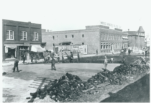Trump’s attacks on free press
By Medicine Hat News Opinon on August 7, 2018.
It’s a big world and U.S. President Donald Trump has been particularly attentive to global affairs of late. There was his love-fest with the Russian president in Helsinki. And then he launched an all-caps Twitter attack on Iran. And, most recently, he applauded Italy’s new populist government for its hard line on immigration. Before that, the European Union was labelled a “foe” and Canada a threat to “national security.” He even saw cause to go after the “very aggressive” folks of Montenegro, suggesting they could drag NATO into World War III. And still, the president found time for one of his favourite enemies: the press. “Don’t believe the crap you see from these people, the fake news,” Trump told an audience in Kansas City, Mo., last week. Then, as the audience booed the attending press corps, he added with an Orwellian twist: “Just remember, what you are seeing and what you are reading is not what’s happening.” It was a chilling performance, even from a man who has called journalists “the enemy of the people.” It’s hard to believe, sometimes, that he’s the purported leader of the free world and lives in a nation that enshrines freedom of the press in its constitution. Trump’s anti-press rhetoric, as the publisher of one of his favourite targets, the New York Times, says, is “not just divisive but increasingly dangerous.” “I warned that this inflammatory language is contributing to a rise in threats against journalists and will lead to violence,” A.G. Sulzberger said, of a meeting with Trump over the issue. He’s not wrong. And the most immediate danger seems to be abroad where journalists routinely put their lives on the line to report on regimes with little tradition of democracy or a free press. Trump’s attacks on the press gives even more licence to those regimes to crack down on media, whose scrutiny they simply don’t like. It threatens burgeoning free speech rights and undermines faith in the media’s efforts to expose those governments’ shortcomings. Indeed, a report published in the Index on Censorship earlier this year found more than 20 political leaders worldwide, from both authoritarian and democratic regimes, had used the term “fake news” to discredit journalism they did not like. Malaysia even passed a law imposing prison sentences of up to six years on people found to be spreading “fake news,” and it is feared the law could be used against journalists and publishers. “The fake news mantra has been weaponized against the entire news media industry,” Tim Franklin, the senior associate dean at the Medill School of Journalism, has warned. “He’s normalizing that narrative against the media internationally.” Trump’s habit of bypassing the media — so he can present his actions in any self-aggrandizing light he chooses to, without comment, context or criticism — is also being copied. Abroad and closer to home. Last spring, for example, Ontario Premier Doug Ford took steps to replace real media — by ending the tradition of having a media bus follow his to cover election campaign rallies and question him on proposed policies — with his own Ford Nation Live. In TV news-style videos on Facebook, Ford had a PC apparatchik pretend to be a reporter while he pretended to present himself for media scrutiny. It’s a channel that Ford has continued within government. And now opposition parties are raising questions about whether this partisan production is being produced on the taxpayers’ dime, no less. This propaganda path is one that Trump started last summer with his “real news” channel. When the media’s ability to fairly criticize and hold governments accountable comes into question, so too does the ability of the public to have an informed debate about the issues. Trump’s acts to undermine a free press affect us all, and we all must stand guard against them. — Toronto Star 24-23




